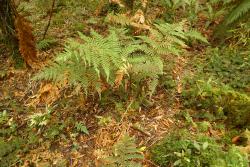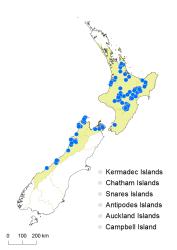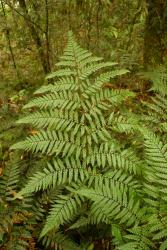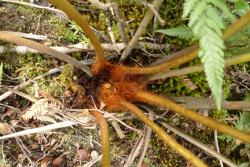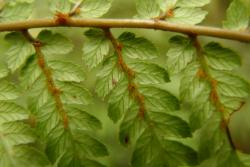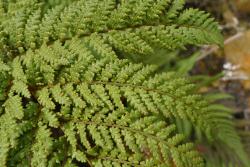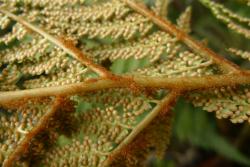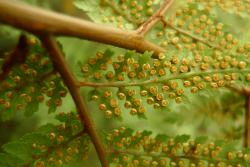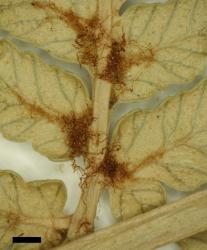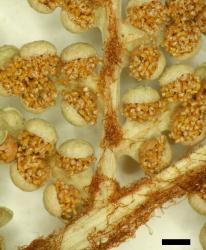- ≡ Dicksonia lanata Colenso ex Hook., Sp. Fil. 1, 69 (1844) var. lanata
Rhizomes prostrate, up to 50 mm diam., branching and stoloniferous; lacking buds, bearing red-brown multicellular hairs near the apex. Fronds 400–1750 mm long, rarely to 2000 mm long, held erect, falling when old; the fertile pinnae only slightly reduced compared with the sterile; dead fronds orange-brown. Stipes 230–1000 mm long, red-brown at very base, becoming yellow-brown or sometimes green distally, smooth, often bearing fine golden-brown hairs at the junction with the rhizome, densely covered in red-brown or chestnut-brown multicellular hairs up to 35 mm long proximally, and pale brown or chestnut-brown hairs to 8 mm long distally. Laminae 2-pinnate-pinnatisect to 3-pinnate (sterile pinnae) or 3-pinnate-pinnatifid (fertile pinnae), ovate or triangular, 240–760 mm long, 140–500 mm wide, pale green on both surfaces, coriaceous, smooth, the sterile segments often slightly revolute; hairy on abaxial surfaces of rachis, pinna midribs and costae; hairs fine, multicellular, pale brown or chestnut-brown, woolly, curled or with occasional straight ones, up to 5 mm long, in dense patches at costa junctions; rachis yellow-brown or green. Primary pinnae in 13–19 pairs, ovate, narrowly ovate or narrowly triangular; the longest below the middle, 95–270 mm long, 35–105 mm wide, stalked; the basal pair 80–230 mm long. Secondary pinnae narrowly ovate or narrowly triangular, the longest 20–60 mm long, 7–17 mm wide, stalked. Longest tertiary pinnae 3–11 mm long, 3–6 mm wide, stalked or sessile or adnate, the fertile ones divided more than halfway to midrib; ultimate segments slightly rounded, bearing a single sorus, or sometimes a pair of sori on the lowermost segments. Sori terminating veins at margins of lamina, ovate, 1–2 mm long, slightly elongated along the lamina margin.
Dicksonia lanata subsp. lanata is very distinctive in being a prostrate plant, lacking the trunk of subsp. hispida. It produces stolons and grows as thick, tangled colonies. It can usually be recognised in most of its range by the dense patches of long, woolly, curled, pale or chestnut-brown hairs that are present on the abaxial surface of the lamina at the costa junctions. Rigid, red-brown hairs are usually absent. However, populations around Thames, at the northernmost limit of the subspecies, are uncharacteristic in having long, rigid, straight, chestnut-brown hairs that are more uniformly distributed. The hairs are longer than in subsp. hispida and are chestnut-brown rather than red-brown. The hair characters of these populations do not accord with those of either subspecies. However, the lack of a trunk suggests that the plants belong to subsp. lanata.
In the absence of hairs, subsp. lanata can sometimes be distinguished by its paler green laminae; sterile lamina segments, which tend to be slightly revolute; fertile pinnae, which are only slightly reduced compared with the sterile; somewhat shorter and broader tertiary pinnae; and more than one sorus on the lowermost ultimate segments of the tertiary pinnae.
North Island: Auckland, Volcanic Plateau, Gisborne, Taranaki, Southern North Island.
South Island: Western Nelson, Sounds-Nelson, Westland.
Altitudinal range: 80–1400 m.
In the North Island D. lanata subsp. lanata occurs in montane forest or open scrub from Thames and Te Aroha south to the Ruahine Ranges, with an outlying population in the southern Tararua Ranges, but is apparently absent from Mt Taranaki. It occurs from about 250 m in southern Coromandel, up to 1100 m in the Urewera region and 1400 m in the Ruahine Ranges. In the South Island it grows mainly in coastal and lowland forest, occurring sporadically in the Marlborough Sounds, and along the west coast from north-west Nelson to Lake Moeraki, South Westland. It grows from about 80 m, reaching 750 m above Boulder Lake, north-west Nelson.
In the North Island, D. lanata subsp. lanata is found in open scrub, and in montane podocarp, beech or broadleaved forest. In the South Island it occurs at lower elevations in mixed podocarp or beech forest.
n = 65 (Brownlie 1961)



